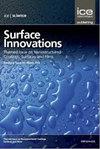Carbon nanofiber aerogel/silicon oxycarbide composites for enhanced electromagnetic interference shielding
IF 3.5
4区 材料科学
Q3 CHEMISTRY, PHYSICAL
引用次数: 3
Abstract
Lightweight electromagnetic interference (EMI) shielding materials under harsh environments are in urgent need to tackle the increasing electromagnetic pollution and hazards. Herein, carbon nanofiber aerogel (CNFA) modified silicon oxycarbide (CNFA/SiOC) composites were prepared following a precursor infiltration pyrolysis procedure by using three-dimensional CNFA as a skeleton. Their structures and mass densities (0.28-1.35 g cm−3) were tunable by adjusting the content of polysiloxane precursor in impregnating solution. The lightweight CNFA/SiOC composite featured with continuous conductive network and highly porous structure in SiOC matrix, resulting in high specific shielding effectiveness (up to 68.9 dB·cm3 g−1 with SETotal of 19.3 dB) due to enhanced conductance loss and multi reflection/scattering. When increasing the density, the CNFA/SiOC composite can deliver EMI shielding effectiveness as high as 27.5 dB due to the generation of defective carbon and carbon dangling bonds as well as abundant interfaces between CNFs and SiOC which induce polarization loss. Moreover, the CNFA/SiOC composite exhibits good oxidation resistance with SETotal retention of above 98% after heat treatment at 600°C for 2 h in air, which arises from the effective protection of CNFs by SiOC.增强电磁干扰屏蔽的纳米碳纤维气凝胶/碳化硅复合材料
恶劣环境下的轻质电磁干扰(EMI)屏蔽材料迫切需要解决日益严重的电磁污染和危害。本文以碳纳米纤维气凝胶(CNFA)为骨架,采用前驱体渗透热解工艺制备了碳纳米纤维-气凝胶改性碳氧化硅(CNFA/SiOC)复合材料。它们的结构和质量密度(0.28-1.35 g cm−3)可通过调节浸渍溶液中聚硅氧烷前体的含量来调节。轻质CNFA/SiOC复合材料具有连续的导电网络和SiOC基体中的高度多孔结构,具有较高的比屏蔽效率(高达68.9 dB·cm3 g−1,SETotal为19.3 dB)。当增加密度时,CNFA/SiOC复合材料可以提供高达27.5的EMI屏蔽效果 dB,这是由于产生有缺陷的碳和碳悬空键以及CNFs和SiOC之间的丰富界面导致的极化损耗。此外,CNFA/SiOC复合材料表现出良好的抗氧化性,在600°C下热处理2小时后,总保持率超过98% h,这源于SiOC对CNFs的有效保护。
本文章由计算机程序翻译,如有差异,请以英文原文为准。
求助全文
约1分钟内获得全文
求助全文
来源期刊

Surface Innovations
CHEMISTRY, PHYSICALMATERIALS SCIENCE, COAT-MATERIALS SCIENCE, COATINGS & FILMS
CiteScore
5.80
自引率
22.90%
发文量
66
期刊介绍:
The material innovations on surfaces, combined with understanding and manipulation of physics and chemistry of functional surfaces and coatings, have exploded in the past decade at an incredibly rapid pace.
Superhydrophobicity, superhydrophlicity, self-cleaning, self-healing, anti-fouling, anti-bacterial, etc., have become important fundamental topics of surface science research community driven by curiosity of physics, chemistry, and biology of interaction phenomenon at surfaces and their enormous potential in practical applications. Materials having controlled-functionality surfaces and coatings are important to the manufacturing of new products for environmental control, liquid manipulation, nanotechnological advances, biomedical engineering, pharmacy, biotechnology, and many others, and are part of the most promising technological innovations of the twenty-first century.
 求助内容:
求助内容: 应助结果提醒方式:
应助结果提醒方式:


